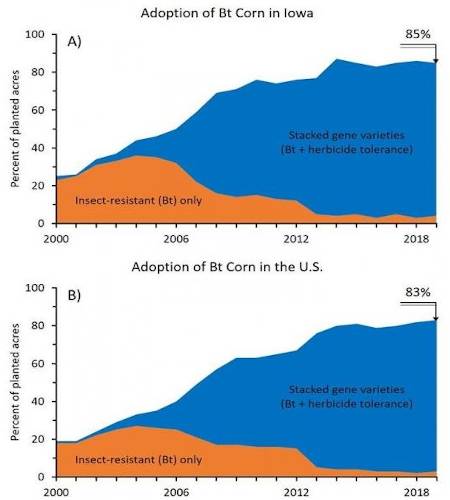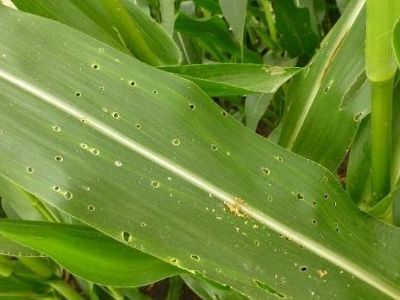By Ashley Dean
Farmers have enjoyed the benefits of Bt corn since its introduction in 1996, particularly “in the bag” transgenic protection from insect pests and the yield loss they inflict. European corn borer (ECB), Ostrinia nubilalis, was particularly challenging and the target of the first Bt hybrids. The adoption of Bt corn in the U.S. prompted a widespread suppression of ECB. Even so, ECB still shows up in conventional cornfields in Iowa and can be a devastating pest.
In 2019, approximately 15% of corn in Iowa and 17% of corn in the U.S. did not contain a Bt trait and would be susceptible to ECB infestation (Figure 1). Non-Bt corn hybrids have been of interest recently due to lower seed costs of non-Bt corn amid low crop values. For farmers who opted out of Bt corn this year, scouting for ECB (and other corn pests) will be essential. A comprehensive guide to understanding ECB and its association with other pests is available from the ISU Extension Store and can serve as a management guide.

Figure 1. Percent of corn acres planted to hybrids with only Bt traits or stacked (Bt + herbicide tolerance) traits in a) Iowa and b) the U.S. Data courtesy of USDA-NASS.
Scouting for European corn borer in conventional corn
A review of the life cycle and identification of ECB can be found here. ECB larvae feed on almost any part of the corn plant except the roots. On leaves, feeding can appear as shotholes or a windowpane effect. They can also tunnel into the stalk, midrib of the leaf, or ear shanks. The result of ECB feeding injury is poor ear development, broken stalks, and dropped ears. Reduced grain quality from ear molds can occur due to ear feeding increasing infection by pathogens.

Figure 2. Feeding by European corn borer larvae can appear as shotholes on the leaves.
There are typically two generations of ECB in Iowa, and each generation has unique scouting requirements to ensure effective management. Life stages and behaviors can be predicted based on degree day accumulation from the date when adults are first captured in the spring, which is called the biofix. Therefore, monitoring for adults is essential for timely scouting and treatment decisions.
First generation: scout for larvae
Corn should be scouted for first generation larvae once susceptible plants reach V6 to determine the number of live larvae. Look for feeding injury in the whorl and on the youngest leaves; plants without these symptoms are unlikely to contain larvae. For every 40-50 acres, 20 consecutive plants should be sampled in five areas to obtain a representative sample of 100 plants. If more than one hybrid is planted in the field, consider each hybrid as a separate field for scouting and treatment determination. A cost-benefit analysis table can help determine if an insecticide is economically justified to control an infestation in vegetative corn (page 9 in the publication). Early-planted fields will likely have higher populations of first-generation ECB.
Second generation: scout for egg masses
Adults produced from the first generation begin laying eggs when the corn is around VT-R1, and egg-laying lasts for about 20 days. Degree days can be used to determine when egg-laying begins (page 5 in the publication), and scouting should occur 8-10 days after that date. Eggs are laid primarily on the underside of leaves. Use the same sampling plan as before (20 consecutive plants in five areas of the field) and count egg masses on seven leaves: the ear leaf plus three leaves above and below the ear leaf. After R3, when silks are brown, scouting for new egg masses is unnecessary if the ET was not reached.
To determine if an insecticide is economically justified, use the cost-benefit analysis table for reproductive stage corn (page 10 in the publication). Treatments for second-generation ECB must be timed accurately to be effective. Applications should be made soon after egg hatch but before larvae enter the leaf axil, sheath, collar, ear tip, or before they bore into the stalk or ear shank. Depending on the duration of egg-laying, a second application may be warranted. Fields at VT-R1 and with green silks are most attractive to female moths. Late-planted corn will typically have the largest population of second-generation ECB.
Source : iastate.edu